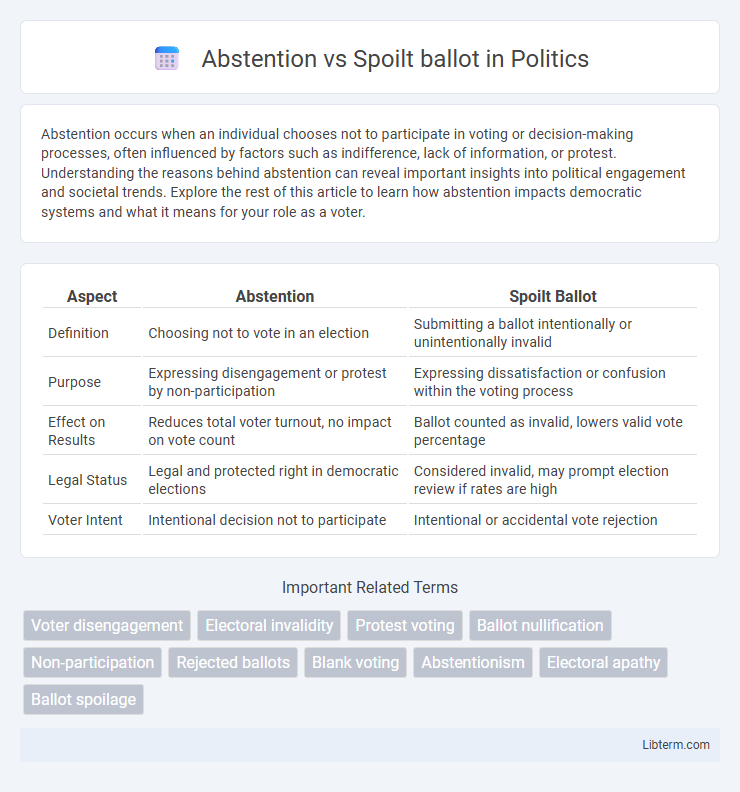Abstention occurs when an individual chooses not to participate in voting or decision-making processes, often influenced by factors such as indifference, lack of information, or protest. Understanding the reasons behind abstention can reveal important insights into political engagement and societal trends. Explore the rest of this article to learn how abstention impacts democratic systems and what it means for your role as a voter.
Table of Comparison
| Aspect | Abstention | Spoilt Ballot |
|---|---|---|
| Definition | Choosing not to vote in an election | Submitting a ballot intentionally or unintentionally invalid |
| Purpose | Expressing disengagement or protest by non-participation | Expressing dissatisfaction or confusion within the voting process |
| Effect on Results | Reduces total voter turnout, no impact on vote count | Ballot counted as invalid, lowers valid vote percentage |
| Legal Status | Legal and protected right in democratic elections | Considered invalid, may prompt election review if rates are high |
| Voter Intent | Intentional decision not to participate | Intentional or accidental vote rejection |
Understanding Abstention and Spoilt Ballots
Abstention occurs when a voter consciously chooses not to cast a vote in an election or referendum, reflecting political disengagement or protest without invalidating the voting process. Spoilt ballots refer to ballots that are deliberately or accidentally marked incorrectly, making them invalid and excluded from the final count. Both abstention and spoilt ballots impact election outcomes by reducing the total number of valid votes and can indicate voter dissatisfaction or confusion.
Definitions: What Is Abstention?
Abstention refers to the deliberate choice by eligible voters to refrain from casting a vote in an election, thereby neither supporting nor opposing any candidate or option. Unlike a spoilt ballot, which is a ballot paper that has been incorrectly marked or defaced and is thus invalidated, abstention indicates a conscious decision to not participate. This distinction is crucial for analyzing voter behavior and understanding electoral participation rates.
Definitions: What Is a Spoilt Ballot?
A spoilt ballot is a voting paper that has been incorrectly marked, damaged, or defaced, rendering it invalid and excluded from the final vote count. Abstention, on the other hand, refers to the conscious decision by a voter to refrain from casting a ballot or choosing not to participate in a specific election or vote. While abstention reflects a deliberate choice not to vote, a spoilt ballot results from errors or deliberate mistakes that invalidate the ballot's intent.
Motivations Behind Abstaining from Voting
Abstention often stems from voter apathy, dissatisfaction with candidates, or a belief that one's vote will not influence the outcome, reflecting a passive form of political disengagement. In contrast, spoilt ballots are intentional acts signaling protest or rejection of all available options, where voters deliberately invalidate their vote to express dissent. Understanding these motivations reveals the complex interplay between political efficacy, voter sentiment, and democratic participation.
Reasons for Spoiling a Ballot
Spoilt ballots occur when voters deliberately mark their papers incorrectly or leave them ambiguous, often due to confusion, protest, or dissatisfaction with candidates or the electoral system. Reasons for spoiling a ballot include intentional defiance as a form of political expression, errors in ballot marking caused by unclear instructions, or misunderstanding of the voting process. Unlike abstention, which reflects non-participation, spoilt ballots actively engage the election process but invalidate the vote.
Legal and Electoral Impacts of Abstention
Abstention, the deliberate choice to not vote, differs fundamentally from a spoilt ballot, which is a vote cast incorrectly or invalidated. Legally, abstention reflects a voter's passive disengagement and does not alter the count of valid votes, potentially skewing the legitimacy and representativeness of election outcomes. Electoral impacts include undermining mandate strength and influencing threshold requirements for candidacy or referendum approval in various jurisdictions.
Effects of Spoilt Ballots on Election Results
Spoilt ballots can significantly impact election outcomes by reducing the total valid vote count, thereby affecting the percentage margins between candidates, especially in tightly contested races. Unlike abstention, which simply reduces voter turnout statistics, spoilt ballots are recorded and can indicate voter dissatisfaction or errors, potentially influencing public perception and prompting calls for electoral reform. High rates of spoilt ballots may alter seat distributions and undermine the legitimacy of elected officials by distorting the accurate representation of voter intent.
Voter Expression: Protest, Discontent, or Apathy
Abstention and spoilt ballots both serve as voter expressions of protest, discontent, or apathy, but differ in intentionality and visibility. Abstention reflects a voluntary choice to not participate, signaling disengagement or rejection of the available options without casting a vote. Spoilt ballots, on the other hand, represent active dissent where voters deliberately invalidate their vote to highlight dissatisfaction with candidates or the electoral system.
Statistical Trends: Abstention vs Spoilt Ballots
Statistical trends reveal that abstention rates typically exceed spoilt ballot percentages in most elections, reflecting voter disengagement rather than voting errors. Analysis from multiple national elections shows abstention rates ranging from 20% to over 40%, while spoilt ballots generally remain below 5%, indicating minimal ballot invalidation. Higher abstention correlates with political dissatisfaction and barriers to voting, whereas spoilt ballots often result from confusion or deliberate protest voting.
Addressing Abstention and Spoilt Ballots in Electoral Reform
Addressing abstention and spoilt ballots is crucial for enhancing electoral integrity and voter representation in democratic systems. Electoral reforms should include measures such as voter education campaigns to clarify voting procedures, streamlined ballot designs to reduce errors, and policies that lower barriers to voting participation. Implementing these strategies can decrease the rates of abstention and invalid ballots, thereby ensuring election outcomes more accurately reflect the electorate's intent.
Abstention Infographic

 libterm.com
libterm.com